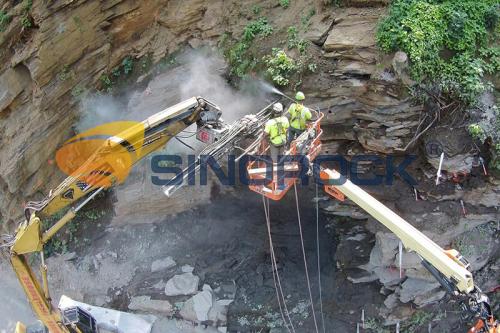Support Technology Combined Self-drilling Soil Nail with Retaining Wall

Introduction of Self-Drilling Hollow Rock Bolt
Composition
Structure
Self-drilling hollow rock bolt is mainly
composed of a hollow bolt body, a nut, a backing plate, a coupler, a centralizer,
and a drill bit. It integrates the functions of drilling, grouting, and
anchoring. Self-drilling hollow bolts can be used for slope support, foundation
pit support, pile foundation support, tunnel tube shed support and system
support, foundation support for transmission towers or wind towers, and repair
of old buildings.
Construction
Advantages
While drilling, it can be connected with a grouting machine for
grouting to achieve the anchoring effect. The construction efficiency is higher
than that of ordinary hollow bolts, and it is suitable for broken and
difficult-to-form surrounding rocks;
There is no need for casing wall protection during construction,
which can greatly improve the construction efficiency, shorten the construction
period and reduce the overall cost of the project;
The hollow bolt body can be arbitrarily cut and lengthened by
connecting sleeves. Therefore, the self-drilling hollow bolt can also be
constructed in narrow spaces where large equipment cannot enter;
Compared with the conventional drill pipe, there are various
types of drill bits, which can be selected according to the properties of
different rock layers and soil during construction, which can improve the
drilling efficiency.
Retaining Wall
A retaining wall refers to a structure that supports the subgrade
fill or hillside soil and prevents the fill or soil from being deformed and
unstable. Retaining walls are generally divided into gravity retaining walls,
anchored retaining walls, thin-wall retaining walls, and reinforced earth
retaining walls. The soil nail type retaining wall belongs to the anchor type
retaining wall in the anchor type retaining wall. The main functions are:
1. The shoulder wall or embankment wall is set below the
high-fill embankment or the steep-slope embankment, which can prevent the
subgrade slope or base from sliding, ensure the stability of the subgrade, and
at the same time shrink the foot of the filling slope, reduce the amount of
filling, and reduce demolition and land occupation. area, and the protection of
existing buildings adjacent to the line;
2. For riverside and reservoir embankments, setting up retaining
walls on the waterside side can prevent the erosion and erosion of the
embankment by the water flow, and is also an effective measure to reduce the
compression of the riverbed or occupy less storage capacity;
3. The retaining wall set at the entrance of the tunnel or the
opening of the tunnel can shorten the length of the tunnel or the opening of
the tunnel and reduce the project cost;
4. The retaining walls set at both ends of the bridge, as wing
walls or abutments, play the role of protecting the abutment and connecting the
embankment;
5. Anti-slip retaining walls can be used to prevent landslides.
Self-drill soil nail retaining wall is a kind of reinforced
retaining wall, which can be used to stabilize roadbeds, prevent slope sliding,
strengthen soft soil foundation, improve the bearing capacity of the foundation,
etc. It is widely used in geotechnical engineering.
Post Your Ad Here
Comments